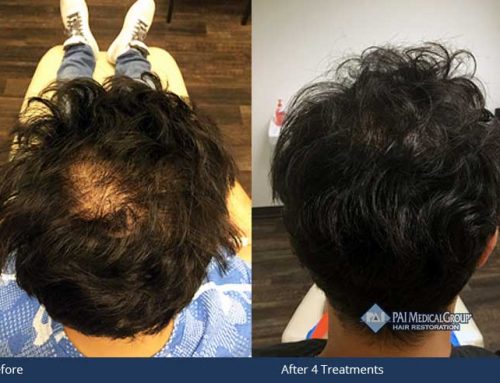Hair loss. It’s an unfortunate thing to happen to the human body, and we can almost guarantee that no one is happy when they see their hair starting to thin or fall out completely. Here are some common hair loss facts that you may not have thought about up until recently. Some of them may surprise you!
Myth #1: Wearing Hats and Shampooing Too Much
This statement is number one on our list because it’s something we hear all the time.
“If you wear a hat too much, you could end up going bald.”
“If you shampoo your hair too frequently and experience product buildup, you could lose your hair.”
“If your pores are clogged, your hair will definitely fall out.”
These are ALL myths. Allow us to explain. Have you ever had a blocked pore from shaving or maybe an ingrown hair somewhere on your body? Your hair eventually grew back, right? Just because you may be blocking your pores, doesn’t mean your hair just magically stops growing. If baldness was due to blocked pores, we could just clear out the pores and allow the hair to grow. This is not the case.
Many people think that by wearing a hat, they’re blocking their scalp from getting outside air. It seems to make sense, right? Wrong! Hair follicles actually get oxygen from the bloodstream rather than the air. You’re more likely to lose hair from other health reasons, or perhaps genes, than from frequently wearing a ballcap.
If you also see your hair coming out when you’re shampooing, don’t panic! It’s completely normal to lose up to 150 strands of hair in a single day, and this commonly happens in the shower.
Myth #2: Old Age = Hair Loss
This is another myth. Several people experience hair loss at several different times in their lives due to many different reasons (what’s considered old age, anyway?). Some as early as 20 and 30-year-olds can experience baldness. According to the American Hair Loss Association, men who are affected by the condition can start seeing early signs of hair loss in their 20s.
There are a lot of health-related reasons and different types of hair loss a person could experience, as well. For example, Alopecia Universalis, a disease in which all body hair falls out including eyebrows, eyelashes, and pubic hair. There’s also Alopecia Areata that causes baldness in children and young teens. There are countless reasons a person could be losing hair but there always seems to be a stigma around old age. It’s something society is always running from and it doesn’t necessarily cause your hair to disappear!
Myth #3: Hair Loss Coming From Mother Or Father?
Can you guess what the number one cause is? It’s hereditary! It’s the most common cause of hair loss, in men and women, and is medically known as androgenetic alopecia.
Technically speaking, baldness isn’t quite caused by your genes. The hair that has fallen out has in fact been replaced by another hair, just a much thinner and finer piece of hair. Either way, you won’t look the same as you did with your regular hair growth cycle.
The good news is, US hair loss specialist, Dr. Alan Bauman recently told Huffington Post that you must lose 50 percent of your hair in order for your baldness to be noticeable to the human eye. That’s a lot of hair. You might not have anything to worry about if you see a few hairs here and there.
There’s also a lot of speculation whether your baldness came from your mother’s side or your father’s side and a dermatologist specializing in hair loss reveals:
“Heredity is the most common cause of hair loss,” she says. “The gene can be inherited from either the mother’s or father’s side of the family, though you’re more likely to be affected if both of your parents had hair loss.” – Dr. Sonia Badreshia-Bansal, WebMD.
Contact Grow Your Hair Back™ Medical Hair Restoration
To learn more about our custom hair restoration procedures and to explore the many advanced hair loss treatment and surgical hair transplant options available to you, we invite you to speak with an experienced Grow Your Hair Back™ hair transplant and hair restoration specialist today. Our goal is to help you find the perfect hair restoration solution to meet your own individual needs and make a well-informed decision about your hair restoration options.





